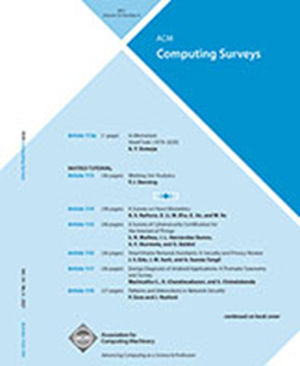Deep Learning Aided Intelligent Reflective Surfaces for 6G: A Survey
IF 23.8
1区 计算机科学
Q1 COMPUTER SCIENCE, THEORY & METHODS
引用次数: 0
Abstract
The envisioned sixth-generation (6G) networks anticipate robust support for diverse applications, including massive machine-type communications, ultra-reliable low-latency communications, and enhanced mobile broadband. Intelligent Reflecting Surfaces (IRS) have emerged as a key technology capable of intelligently reconfiguring wireless propagation environments, thereby enhancing overall network performance. Traditional optimization techniques face limitations in meeting the stringent performance requirements of 6G networks due to the intricate and dynamic nature of the wireless environment. Consequently, Deep Learning (DL) techniques are employed within the IRS framework to optimize wireless system performance. This paper provides a comprehensive survey of the latest research in DL-aided IRS models, covering optimal beamforming, resource allocation control, channel estimation and prediction, signal detection, and system deployment. The focus is on presenting promising solutions within the constraints of different hardware configurations. The survey explores challenges, opportunities, and open research issues in DL-aided IRS, considering emerging technologies such as digital twins (DTs), computer vision (CV), blockchain, network function virtualization (NFC), integrated sensing and communication (ISAC), software-defined networking (SDN), mobile edge computing (MEC), unmanned aerial vehicles (UAVs), and non-orthogonal multiple access (NOMA). Practical design issues associated with these enabling technologies are also discussed, providing valuable insights into the current state and future directions of this evolving field.面向 6G 的深度学习辅助智能反射表面:一项调查
设想中的第六代(6G)网络将为各种应用提供强大的支持,包括大规模机器型通信、超可靠低延迟通信和增强型移动宽带。智能反射面(IRS)已成为一项关键技术,能够智能地重新配置无线传播环境,从而提高整体网络性能。由于无线环境的复杂性和动态性,传统的优化技术在满足 6G 网络严格的性能要求方面面临限制。因此,在 IRS 框架内采用了深度学习(DL)技术来优化无线系统性能。本文全面介绍了深度学习辅助 IRS 模型的最新研究成果,涵盖优化波束成形、资源分配控制、信道估计和预测、信号检测和系统部署。重点是在不同硬件配置的限制条件下提出有前景的解决方案。考虑到数字孪生(DT)、计算机视觉(CV)、区块链、网络功能虚拟化(NFC)、集成传感与通信(ISAC)、软件定义网络(SDN)、移动边缘计算(MEC)、无人机(UAV)和非正交多址接入(NOMA)等新兴技术,本调查探讨了数字线路辅助 IRS 所面临的挑战、机遇和开放研究课题。还讨论了与这些使能技术相关的实际设计问题,为了解这一不断发展领域的现状和未来方向提供了宝贵的见解。
本文章由计算机程序翻译,如有差异,请以英文原文为准。
求助全文
约1分钟内获得全文
求助全文
来源期刊

ACM Computing Surveys
工程技术-计算机:理论方法
CiteScore
33.20
自引率
0.60%
发文量
372
审稿时长
12 months
期刊介绍:
ACM Computing Surveys is an academic journal that focuses on publishing surveys and tutorials on various areas of computing research and practice. The journal aims to provide comprehensive and easily understandable articles that guide readers through the literature and help them understand topics outside their specialties. In terms of impact, CSUR has a high reputation with a 2022 Impact Factor of 16.6. It is ranked 3rd out of 111 journals in the field of Computer Science Theory & Methods.
ACM Computing Surveys is indexed and abstracted in various services, including AI2 Semantic Scholar, Baidu, Clarivate/ISI: JCR, CNKI, DeepDyve, DTU, EBSCO: EDS/HOST, and IET Inspec, among others.
 求助内容:
求助内容: 应助结果提醒方式:
应助结果提醒方式:


